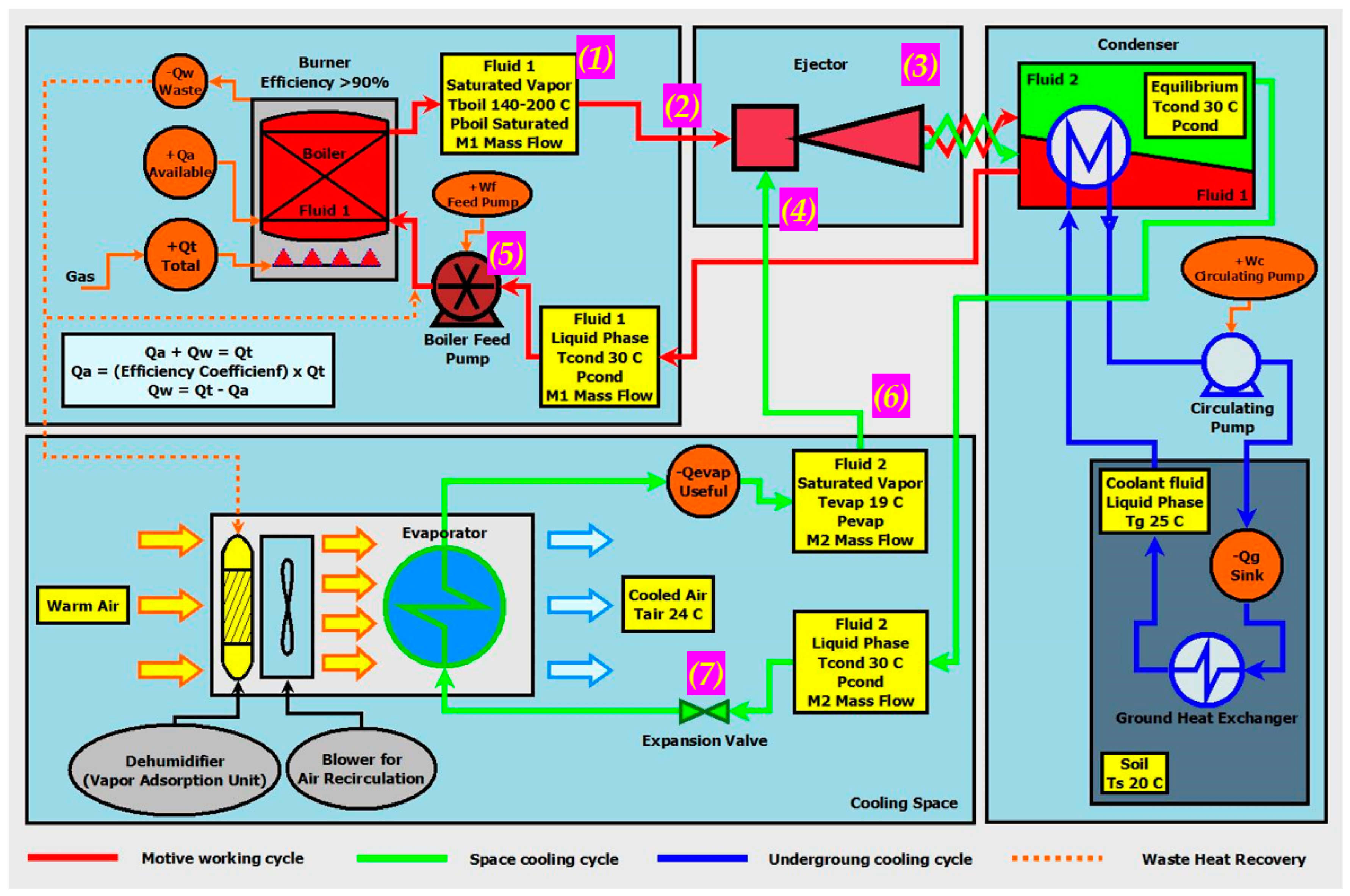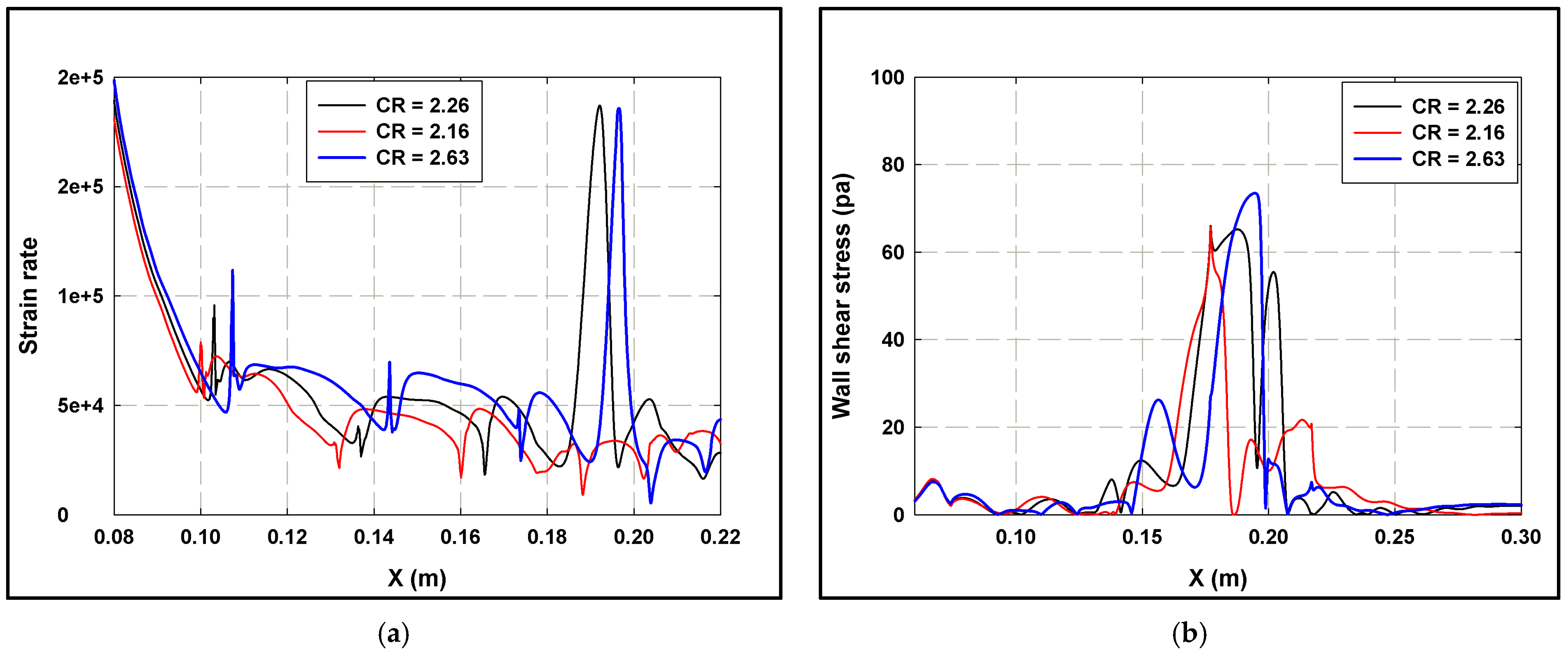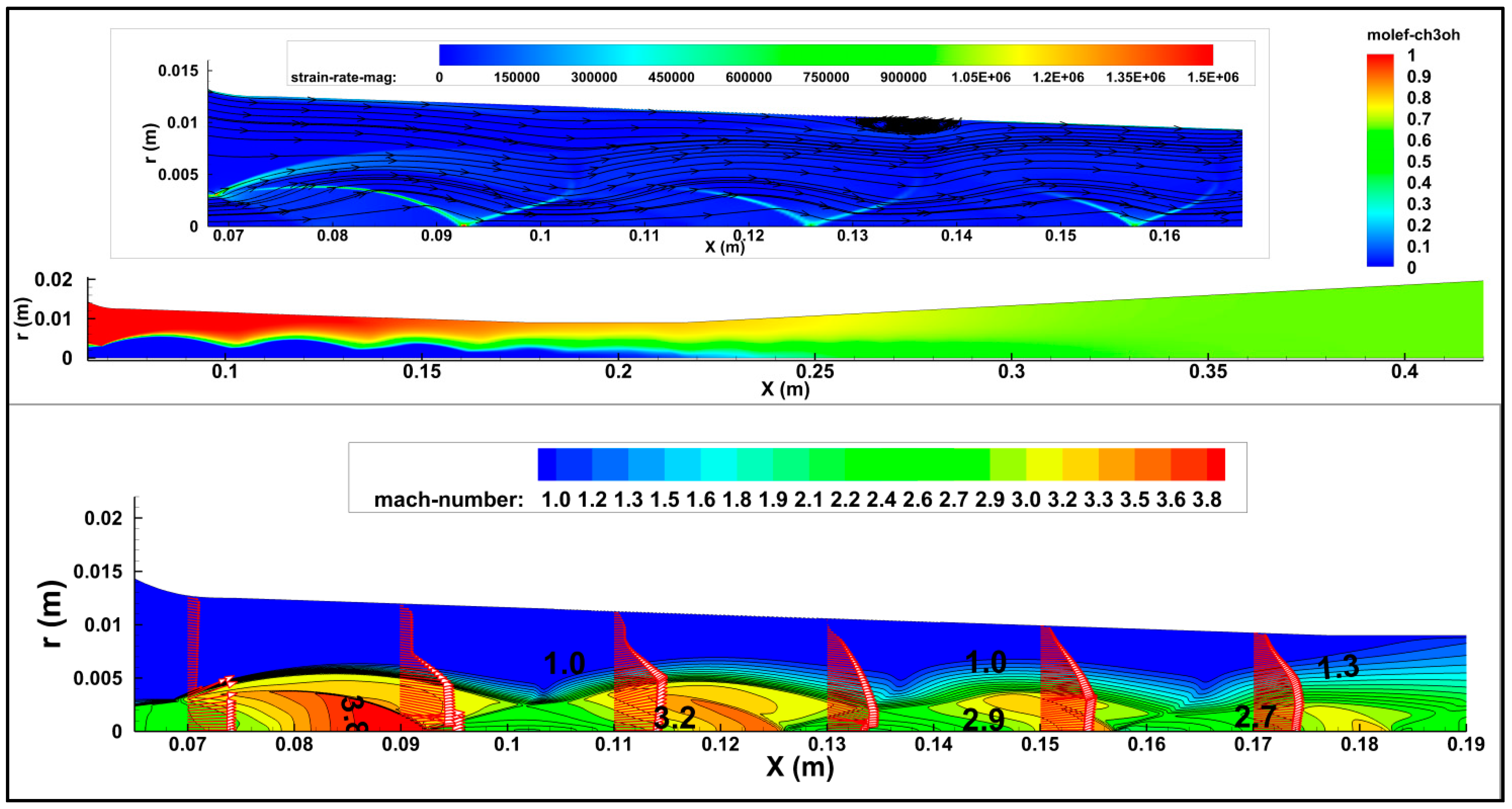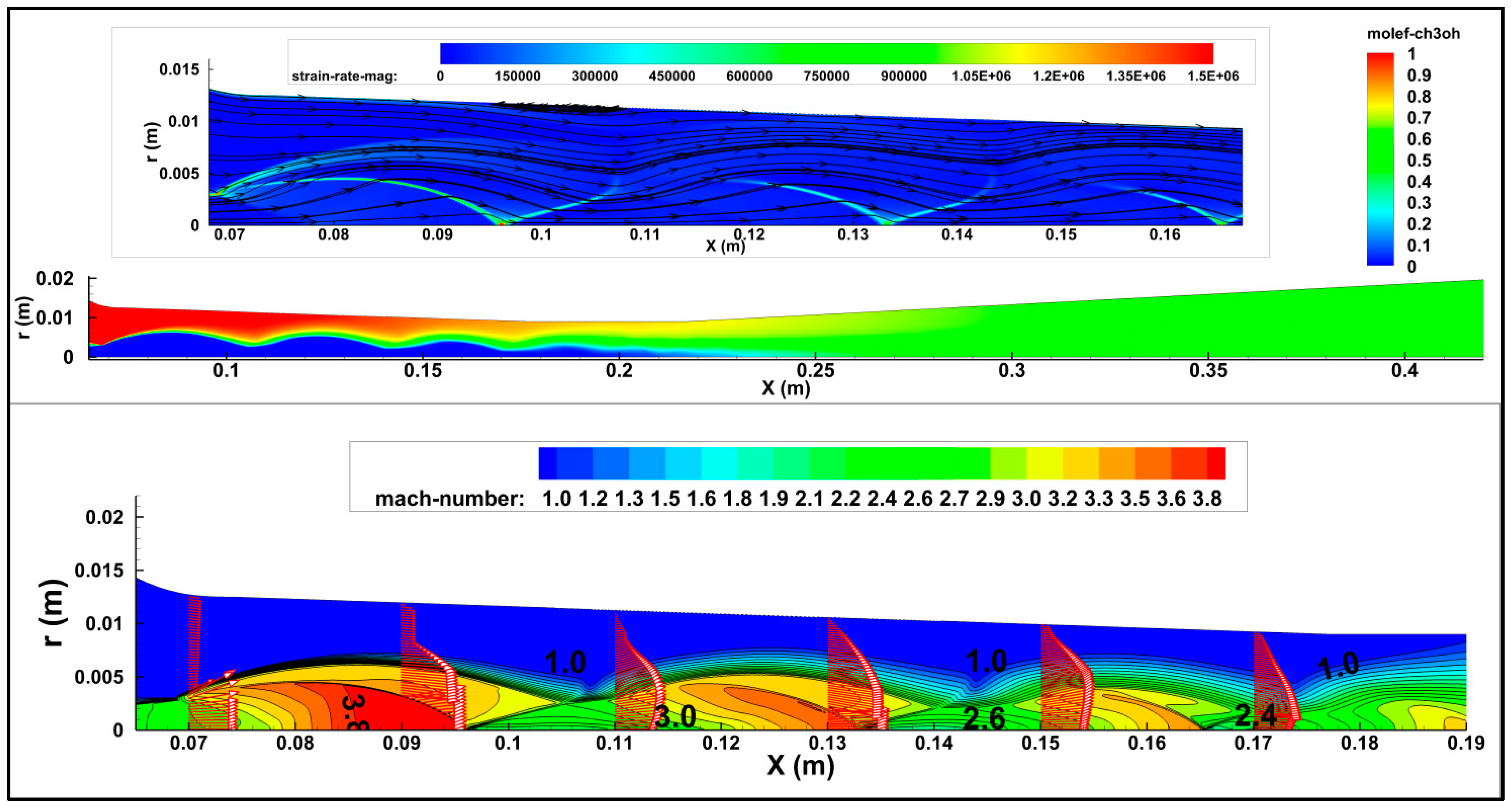System COP of Ejector-Based Ground-Source Heat Pumps
Abstract
1. Introduction
2. Estimation of the Energy Losses in the BFE GSHP Cooling System
- ⮚
- Boiler pressure vessel/gas burner (efficiency > 90%), where the primary (motive) fluid is turned to vapor to drive the ejector, and the boiler feed pump returns primary fluid to the boiler to complete the cycle.
- ⮚
- Binary Fluid Ejector, where the secondary fluid (refrigerant) is entrained and compressed by the primary fluid.
- ⮚
- Cooling space, where the evaporator is employed for air cooling. A vapor chemical adsorption unit could also be installed to improve cooling efficiency. Existing HVAC air blowers and humidifiers may be reused in retrofit situations.
- ⮚
- Condenser with ground loop. Cooling, condensing, and separating the fluid mixture occurs in the condenser, while heat rejection takes place in the underground liquid-based loop (with pump-driven coolant recirculation).
- K1 accounts for the expansion process and the cooling through the expansion valve,
- is the boiler feed pump power,
- Prp is the ground loop circulating pump power,
- and are the enthalpy of vaporization at the evaporator (secondary fluid) and the boiler (primary fluid) temperature,
- and are the average specific heat capacity of the primary fluid (between the boiler and condenser) and the secondary fluid (between the evaporator and condenser),
- and are the mass flow rate of the primary and the secondary fluids,
- TBoil, TEvap, and TCond are the saturation temperature in the Boiler, Evaporator, and Condenser.
2.1. Boiler Feed Pump Energy Consumption
- At the pump inlet:
- ○
- The fluid is in a liquid phase with a density .
- ○
- The fluid temperature corresponds to that of the condenser: TCond = 30 °C.
- ○
- The fluid pressure is constant and equal to the condenser pressure PCond.
- ○
- The fluid mass flow rate depends on the ejector’s performance.
- At the pump outlet:
- ○
- The fluid is in a liquid phase and considered incompressible with the same density 1.
- ○
- The fluid temperature corresponds to the boiler temperature TBoil.
- ○
- The fluid pressure is constant and equal to the boiler pressure PBoil.
- ○
- The fluid mass flow rate is .
- The fluid is first pressurized adiabatically and injected into the boiler.
- The fluid is then heated isobarically at the boiler pressure PBoil to the boiler temperature TBoil.
2.2. Expansion Valve Analysis
- At the expansion valve inlet:
- ○
- The fluid is in liquid phase with density .
- ○
- The fluid temperature is at the condenser temperature TCond = 30 °C.
- ○
- The fluid pressure is constant and equal to the condenser pressure PCond.
- ○
- The fluid mass flow rate is defined by ejector’s efficiency.
- For the fluid coming through the expansion valve:
- ○
- The fluid pressure is changed to the evaporator pressure PEvap.
- ○
- The fluid is in a liquid phase and considered incompressible with the same density 2.
- ○
- The fluid temperature drops due to the expansion work to a temperature TEV.
- ○
- The fluid mass flow rate is .
- At the expansion valve outlet:
- ○
- The fluid pressure remains at the evaporator pressure PEvap.
- ○
- The fluid temperature turns into the evaporator temperature TEvap = 19 °C.
- ○
- In order to achieve the temperature drop, the fluid coming out of the expansion valve is a mixture of liquid and gas phases with respective mass flow rates and .
- ○
- The fluid mass flow rate = + is conserved.
- ⮚
- The fluid is expanded adiabatically and cooled down to a transitional temperature TEV. This corresponds to the estimation of the power needed for the expansion process.
- ⮚
- If TEV is greater than the evaporator temperature (TEvap), then the fluid is cooled down isobarically to the evaporator temperature.
- QL represents the heat rejected during the cooling down of the liquid portion,
- CpL is the heat capacity of the liquid phase at the evaporator conditions,
- QG corresponds to the heat rejected during the cooling down of the gas portion,
- CpG is the heat capacity of the gas phase at the evaporator conditions,
- Qph is the heat rejected during the phase change process,
- Hv2 is the enthalpy of vaporization of the secondary fluid at the condenser conditions.
2.3. Ground Loop Pump Analysis
- The heat rejected into the ground is generated by the boiler and the evaporator.
- The boiler heat generation consists of two parts:
- ○
- The primary fluid is preheated to the boiler’s set temperature.
- ○
- The phase change of the preheated fluid occurs, and saturated vapor is produced.
- The heat generated in the evaporator is mainly defined by the phase change process.
- is the amount of heat required for the primary fluid preheating,
- is the heat capacity at the boiler conditions,
- is the heat load needed for the phase change of the primary fluid,
- is the enthalpy of vaporization of the primary fluid at the boiler conditions.
- is the heat generated in the evaporator,
- is the enthalpy of vaporization of the secondary fluid at the evaporator conditions.
3. System COP Estimation
4. Influence of the Condenser Temperature on the System Performance
5. Conclusions
- The overall COP of a BFE GSHP system providing space-cooling duty was given for a short list of binary fluid candidates and operating conditions. It was found that the lowest COP of 1.55 corresponds to the highest compression ratio of 2.36, while the highest reported COP of 3.06 is found at the lowest compression ratio of 1.55. It should be noted that the optimization of the ejector geometry based on the binary fluids selected should be further studied; it has the potential to increase the system COP.
- The energy performance of an ejector-based GSHP system can be influenced by three primary factors: the boiler feed pump, the refrigeration expansion valve, and the ground loop circulating pump. The work done by each of these components was calculated in the present paper. It was found that the effect of both the boiler feed pump and the expansion valve on the system COP was small for the fluid pairs and the operating conditions of the present study. On the other hand, it was shown that the energy demand of the ground loop circulation pump, required to maintain a constant differential temperature across the GHX, was around 151 watts. Therefore, the total work was significantly smaller than the available energy in the BFE GSHP cooling system.
- The influence of the condenser temperature on the system COP was studied for two additional saturation temperatures of 28 and 32 °C and for three binary fluid candidates. An increase as high as 21.3% in the system COP was observed for TCond = 28 °C, whereas the strongest decrease was around 33.3% for TCond = 32 °C. The CFD results showed that the condenser temperature variation influenced both the strain rate and the wall shear stress distributions and thus affected the mixing between the two working fluids and the friction losses. In addition, the sensitivity of both the shape and the location of the separation bubble (inside the mixing chamber) to the condenser temperature is also responsible for the entrainment ratio variation. Such mechanisms should be considered for optimization purposes or flow control strategies.
Funding
Data Availability Statement
Conflicts of Interest
Abbreviation
| Acronyms | |
| BFE GSHP | Binary Fluid Ejector Ground Source Heat Pump |
| COP | Coefficient of Performance |
| CFD | Computational Fluid Dynamics |
| CR | Compression Ratio |
| M1 | Molecular mass of the primary fluid |
| M2 | Molecular mass of the secondary fluid |
| Symbols | |
| TBoil | Boiler Saturation Temperature |
| TEvap | Evaporator Saturation Temperature |
| TCond | Condenser Saturation Temperature |
| PBoil | Boiler Saturation Pressure |
| PEvap | Evaporator Saturation Pressure |
| PCond | Condenser Saturation Pressure |
| Enthalpy of vaporization in the Evaporator (secondary fluid) | |
| Enthalpy of vaporization in the Boiler (primary fluid) | |
| Average specific heat capacity of primary fluid | |
| Average specific heat capacity of secondary fluid | |
| Mass entrainment ratio | |
| Boiler feed pump power | |
| Volume flow rate through the boiler feed pump | |
| Mass flow rate through the boiler feed pump | |
| Mass flow rate of liquid exiting the expansion valve | |
| Mass flow rate of gas exiting the expansion valve | |
| = | |
| Density of the liquid flowing through the boiler feed pump | |
| Ground loop circulating pump power | |
| CPL | Heat capacity of the liquid phase at the evaporator conditions |
| Heat capacity of the gas phase at the evaporator conditions | |
| Heat capacity at the boiler conditions | |
| Amount of heat required for the primary fluid preheating | |
| Heat load needed for the phase change of the primary fluid | |
| Amount of heat generated in the evaporator | |
References
- El Hassan, M. Numerical Characterization of the Flow Dynamics and COP Estimation of a Binary Fluid Ejector ground Source Heat Pump Cooling System. Fluids 2022, 7, 250. [Google Scholar] [CrossRef]
- El Zohbi, B.; Bukharin, N.; Assoum, H.H.; Abed-Meraim, K.; Sakout, A.; El Hassan, M. Investigation of the effects of the jet nozzle geometry and location on the performance of supersonic fluid ejectors. Energy Rep. 2022, 8, 228–233. [Google Scholar] [CrossRef]
- El Hassan, M.; Assoum, H.H.; Bukharin, N.; Abed-Meraim, K.; Sakout, A. Investigation of thermo-physical fluid properties effect on binary fluid ejector performance. Energy Rep. 2020, 6, 287–292. [Google Scholar] [CrossRef]
- El Hassan, M. Numerical Investigation of the Flow Dynamics inside Supersonic Fluid Ejector. Arab. J. Sci. Eng. 2019, 45, 909–919. [Google Scholar] [CrossRef]
- El Hassan, M.; Gubanov, A.; May, W.; Martinuzzi, R. Numerical investigation of the flow dynamics of a supersonic fluid ejector. In Proceedings of the International Conference on Heat Transfer and Fluid Flow, Prague, Czech Republic, 11–12 August 2014. [Google Scholar]
- Buyadgie, O.; Drakhnia, O.; Miyazaki, T. The analysis of binary fluid ejector assisted solar desalination system. In Proceedings of the 17th International Refrigeration and Air Conditioning Conference, West Lafayette, IN, USA, 9–12 July 2018. [Google Scholar]
- Ameur, K.; Aidoun, Z. Nozzle Displacement Effects on Two-Phase Ejector Performance: An Experimental Study. J. Appl. Fluid Mech. 2018, 11, 817–823. [Google Scholar] [CrossRef]
- Wen, C.; Rogie, B.; Kærn, M.R.; Rothuizen, E. A first study of the potential of integrating an ejector in hydrogen fueling stations for fuelling high pressure hydrogen vehicles. Appl. Energy 2020, 260, 113958. [Google Scholar] [CrossRef]
- Friso, D. Mathematical Modelling of the Entrainment Ratio of High Performance Supersonic Industrial Ejectors. Processes 2022, 10, 88. [Google Scholar] [CrossRef]
- Sun, D.W.; Eames, I.W. Recent development in the design theories and applications of ejectors—A review. J. Inst. Energy 1995, 68, 65–79. [Google Scholar]
- Chunnanond, K.; Aphornratana, S. Ejectors: Applications in refrigeration technology. Renew. Sustain. Energy Rev. 2004, 8, 129–155. [Google Scholar] [CrossRef]
- Eames, I.W.; Aphornratana, S.; Haider, H. A theoretical and experimental study of a small-scale steam jet refrigerator. Int. J. Refrig. 1995, 18, 378–386. [Google Scholar] [CrossRef]
- Eames, I.W. A new prescription for the design of supersonic jet pumps: The constant rate of momentum change method. Appl. Therm. Eng. 2002, 22, 121–131. [Google Scholar] [CrossRef]
- Chunnanond, K.; Aphornratana, S. An Experimental investigation of a steam ejector refrigerator: The analysis of the pressure profile along the ejector. Appl. Therm. Eng. 2004, 27, 311–322. [Google Scholar] [CrossRef]
- Smierciew, K.; Gagan, J.; Butrymowicz, D. Application of numerical modelling for design and improvement of performance of gas ejector. Appl. Therm. Eng. 2019, 149, 85–93. [Google Scholar] [CrossRef]
- Surya, S.D.; Vasu, T.A.; Raghavan, K.S.; Murthy, C. CFD simulation of ejector in steam jet refrigeration. J. Appl. Mech. Eng. 2017, 6, 263. [Google Scholar] [CrossRef]
- Ruangtrakoon, N.; Thongtip, T.; Aphornratana, S.; Sriveerakul, T. CFD simulation on the effect of primary nozzle geometries for a steam ejector in refrigeration cycle. Int. J. Therm. Sci. 2013, 63, 133–145. [Google Scholar] [CrossRef]
- Thongtip, T.; Aphornratana, S. An experimental analysis of the impact of primary nozzle geometries on the ejector performance used in R141b ejector refrigerator. Appl. Therm. Eng. 2017, 110, 89–101. [Google Scholar] [CrossRef]
- Poirier, M.; Giguère, D.; Sapoundjiev, H. Experimental parametric investigation of vapor ejector for refrigeration applications. Energy 2018, 162, 1287–1300. [Google Scholar] [CrossRef]
- Ramesh, A.S.; Sekhar, S.J. Experimental and numerical investigations on the effect of suction chamber angle and nozzle exit position of a steam-jet ejector. Energy 2018, 164, 1097–1113. [Google Scholar] [CrossRef]
- Eames, I.W.; Ablwaifa, A.E.; Petrenko, V. Results of an experimental study of an advanced jet-pump refrigerator operating with R245fa. Appl. Therm. Eng. 2007, 27, 2833–2840. [Google Scholar] [CrossRef]
- Sankarlal, T.; Mani, A. Experimental investigations on ejector refrigeration system with ammonia. Renew. Energy 2007, 32, 1403–1413. [Google Scholar] [CrossRef]
- Buyadgie, D.I.; Nichenko, S.V.; Buyadgie, O.D. Novel ejector cooling technologies using binary fluids. In Proceedings of the 9th International Conference on Sustainable Energy Technologies, Shanghai, China, 24–27 August 2010. [Google Scholar]
- Buyadgie, D.; Buyadgie, O.; Artemenko, S.V.; Chamchine, A.; Drakhnia, O. Conceptual design of binary/multicomponent fluid ejector refrigeration systems. Int. J. Low-Carbon Technol. 2012, 7, 120–127. [Google Scholar] [CrossRef]
- Xiao, J.; Wu, Q.; Chen, L.; Ke, W.; Wu, C.; Yang, X.; Yu, L.; Jiang, H. Assessment of Different CFD Modeling and Solving Approaches for a Supersonic Steam Ejector Simulation. Atmosphere 2022, 13, 144. [Google Scholar] [CrossRef]
- Han, Y.; Wang, X.; Sun, H.; Zhang, G.; Guo, L.; Tu, J. CFD simulation on the boundary layer separation in the steam ejector and its influence on the pumping performance. Energy 2019, 167, 469–483. [Google Scholar] [CrossRef]
- Liu, X.; Munk, J. Field Test and Evaluation of Residential ground Source Heat Pump Systems Using Emerging ground Coupling Technologies. In Proceedings of the 11th International Energy Agency Heat Pump Conference, Montréal, QC, Canada, 11–12 May 2014. [Google Scholar]
- Varga, S.; Lebre, P.S.; Oliveira, A.C. Readdressing working fluid selection with a view to designing a variable geometry ejector. Int. J. Low-Carbon Technol. 2015, 10, 205–215. [Google Scholar] [CrossRef]
- RETScreen International Clean Energy Decision Support Centre. “Clean Energy Project Analysis: Retscreen Engineering & Cases Textbook, Ground-Source Heat Pump Project Analysis Chapter” Minister of Natural Resources Canada 2001–2005. 2005. Available online: http://www.alternativesynergy.org/SEDV-work/Project/RETScreen/Textbook_Intro.pdf (accessed on 1 October 2022).
- Menter, F.R. Two-equation eddy viscosity turbulence models for engineering applications. AIAA J. 1994, 32, 1598–1605. [Google Scholar] [CrossRef]
- Bartosiewicz, Y.; Aidoun, Z.; Desevaux, P.; Mercadier, Y. Numerical and experimental investigations on supersonic ejectors. Int. J. Heat Fluid Flow 2005, 26, 56–70. [Google Scholar] [CrossRef]
- Hanafi, A.S.; Mostafa, G.M.; Waheeda, A.; Fathya, A. 1-D Mathematical Modeling and CFD Investigation on Supersonic Steam Ejector in MED-TVC. In Proceedings of the 7th International Conference on Applied Energy—ICAE 2015, Abu Dhabi, United Arab Emirates, 28–31 March 2015. [Google Scholar]
- Kong, F.; Kim, H.D. Analytical and computational studies on the performance of a two-stage ejector–diffuser system. Int. J. Heat Mass Transf. 2015, 85, 71–87. [Google Scholar] [CrossRef]





| Primary Fluid | Secondary Fluid | 1 (g/s) | (Kg/m3) | (Kg/m3) | PEvap (KPa) | PCond (KPa) | PBoil (KPa) | 1 (J/s) | 2 (J/s) | (g/s) |
|---|---|---|---|---|---|---|---|---|---|---|
| difluorodiiodomethane | methanol | 25 | 3508 | 792 | 12.31 | 29.1 | 1030 | 7.13 | 0.11 | 0.12 |
| bromofluoroiodomethane | methanol | 21.1 | 2880 | 792 | 12.31 | 27 | 1000 | 7.13 | 0.10 | 0.13 |
| bromotrichloromethane | methanol | 16.2 | 2005 | 792 | 12.31 | 28 | 830 | 6.48 | 0.12 | 0.14 |
| Chloroiodomethane | acetonitrile | 13.3 | 2501 | 786 | 8.9 | 17.7 | 700 | 3.63 | 0.05 | 0.10 |
| ethylenedibromo | acetonitrile | 13.7 | 2280 | 786 | 8.9 | 17.5 | 700 | 4.10 | 0.05 | 0.10 |
| 2-chloropropenoyl fluoride | methanol | 17.5 | 1250 | 792 | 12.31 | 29 | 1200 | 16.39 | 0.13 | 0.15 |
| 3-methylthiophene | methanol | 10.8 | 1022 | 792 | 12.31 | 25.5 | 800 | 8.18 | 0.10 | 0.15 |
| methanedithiol | methanol | 13.3 | 1800 | 792 | 12.31 | 29 | 1200 | 8.65 | 0.15 | 0.17 |
| 1-methoxycyclopentene | methanol | 10.6 | 916 | 792 | 12.31 | 25.2 | 770 | 8.62 | 0.11 | 0.16 |
| Fluid Pair | (g/s) | (g/s) | TBoil (°C) | TCond (°C) | Cp1 J/(g.K) | Hv1 (J/g) | Hv2 (J/g) | Q1 (kW) | Q1p (KW) | Q2p (KW) | Qt (KW) | (kg/s) | ||
|---|---|---|---|---|---|---|---|---|---|---|---|---|---|---|
| # | Primary | Secondary | ||||||||||||
| 1 | difluorodiiodomethane | methanol | 25 | 5.2 | 200 | 30 | 0.47 | 86.2 | 1178.8 | 2.01 | 2.16 | 6.13 | 10.30 | 0.49 |
| 2 | bromofluoroiodomethane | methanol | 21.1 | 5.6 | 210 | 30 | 0.53 | 108.2 | 1178.8 | 2.01 | 2.28 | 6.60 | 10.90 | 0.52 |
| 3 | bromotrichloromethane | methanol | 16.2 | 5.9 | 210 | 30 | 0.76 | 127.1 | 1178.8 | 2.21 | 2.06 | 6.96 | 11.23 | 0.53 |
| Pipe Section | Pipe Wall Roughness (mm) | Section Length (m) | Diameter (mm) | Water Average Temperature (°C) | Water Mass Flow (kg/s) | Water Density (kg/m3) | Water Kinematic Viscosity (cm2/s) | Reynolds Number | Flow Regime | Mean Velocity (m/s) | Pressure Drop (kPa) | Total Pressure Drop (kPa) |
|---|---|---|---|---|---|---|---|---|---|---|---|---|
| Plastic | 0.02 | 250 | 25.4 | 27.5 | 0.53 | 996.33 | 0.0084466 | 31,569 | turbulent | 1.05 | 136 | 284 |
| Steel | 0.03 | 25 | 15.9 | 27.5 | 0.53 | 996.33 | 0.0084466 | 50,511 | turbulent | 2.69 | 148 |
| Primary Fluid | Secondary Fluid | (g/s) | (g/s) | TBoil (°C) | 1 (J/s) | Prp (W) | COP | System COP | ||
|---|---|---|---|---|---|---|---|---|---|---|
| CF2I2 | CH3OH | 25.0 | 5.2 | 200 | 9.0 | 140 | 0.12 | 2.36 | 1.60 | 1.55 |
| CF2I2 | CH3OH | 17.5 | 5.5 | 178 | 4.0 | 126 | 0.13 | 1.78 | 2.50 | 2.43 |
| CF2I2 | CH3OH | 15.2 | 5.7 | 171 | 3.0 | 124 | 0.14 | 1.57 | 3.00 | 2.92 |
| CHBrFI | CH3OH | 21.1 | 5.6 | 210 | 8.8 | 148 | 0.13 | 2.19 | 1.69 | 1.64 |
| CHBrFI | CH3OH | 17.8 | 6.0 | 200 | 6.0 | 144 | 0.14 | 1.79 | 2.18 | 2.12 |
| CHBrFI | CH3OH | 14.4 | 5.9 | 190 | 3.7 | 133 | 0.14 | 1.57 | 2.66 | 2.58 |
| BrCCl3 | CH3OH | 16.2 | 5.9 | 210 | 8.2 | 152 | 0.14 | 2.27 | 1.79 | 1.74 |
| BrCCl3 | CH3OH | 13.4 | 6.0 | 187 | 5.3 | 141 | 0.14 | 1.75 | 2.27 | 2.20 |
| BrCCl3 | CH3OH | 10.2 | 6.2 | 171 | 2.9 | 132 | 0.15 | 1.55 | 3.15 | 3.06 |
| Primary Fluid | Secondary Fluid | M1 (g/mol) | M2 (g/mol) | M1/M2 | PEvap (Kpa) | PCond (Kpa) | PBoil (Mpa) | TBoil (°C) | TCond (°C) | CR | (g/s) | (g/s) | ER | COP |
|---|---|---|---|---|---|---|---|---|---|---|---|---|---|---|
| CHBrFI | CH3OH | 238.83 | 32.04 | 7.45 | 12.31 | 27.00 | 1.00 | 220.00 | 30.00 | 2.09 | 21.20 | 5.60 | 0.26 | 1.64 |
| CHBrFI | CH3OH | 238.83 | 32.04 | 7.45 | 12.31 | 24.98 | 0.90 | 210.00 | 28.00 | 2.03 | 19.40 | 5.50 | 0.28 | 1.73 |
| CHBrFI | CH3OH | 238.83 | 32.04 | 7.45 | 12.31 | 30.44 | 1.10 | 225.00 | 32.00 | 2.47 | 23.33 | 5.30 | 0.23 | 1.39 |
| CF2I2 | CH3OH | 304.00 | 32.00 | 9.50 | 12.31 | 29.10 | 1.03 | 200.00 | 30.00 | 2.26 | 25.00 | 5.20 | 0.21 | 1.55 |
| CF2I2 | CH3OH | 304.00 | 32.00 | 9.50 | 12.31 | 26.55 | 0.85 | 190.00 | 28.00 | 2.16 | 21.05 | 5.20 | 0.25 | 1.88 |
| CF2I2 | CH3OH | 304.00 | 32.00 | 9.50 | 12.31 | 32.38 | 1.20 | 209.00 | 32.00 | 2.63 | 29.10 | 4.90 | 0.17 | 1.24 |
| BrCCl3 | CH3OH | 198.00 | 32.00 | 6.19 | 12.31 | 28.00 | 0.83 | 210.00 | 30.00 | 2.17 | 16.20 | 5.90 | 0.36 | 1.74 |
| BrCCl3 | CH3OH | 198.00 | 32.00 | 6.19 | 12.31 | 26.10 | 0.83 | 210.00 | 28.00 | 2.12 | 16.20 | 5.70 | 0.35 | 1.68 |
| BrCCl3 | CH3OH | 198.00 | 32.00 | 6.19 | 12.31 | 31.83 | 1.10 | 220.00 | 32.00 | 2.59 | 21.20 | 5.30 | 0.25 | 1.16 |
Publisher’s Note: MDPI stays neutral with regard to jurisdictional claims in published maps and institutional affiliations. |
© 2022 by the author. Licensee MDPI, Basel, Switzerland. This article is an open access article distributed under the terms and conditions of the Creative Commons Attribution (CC BY) license (https://creativecommons.org/licenses/by/4.0/).
Share and Cite
El Hassan, M. System COP of Ejector-Based Ground-Source Heat Pumps. Energies 2022, 15, 8509. https://doi.org/10.3390/en15228509
El Hassan M. System COP of Ejector-Based Ground-Source Heat Pumps. Energies. 2022; 15(22):8509. https://doi.org/10.3390/en15228509
Chicago/Turabian StyleEl Hassan, Mouhammad. 2022. "System COP of Ejector-Based Ground-Source Heat Pumps" Energies 15, no. 22: 8509. https://doi.org/10.3390/en15228509
APA StyleEl Hassan, M. (2022). System COP of Ejector-Based Ground-Source Heat Pumps. Energies, 15(22), 8509. https://doi.org/10.3390/en15228509






